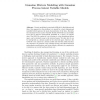Free Online Productivity Tools
i2Speak
i2Symbol
i2OCR
iTex2Img
iWeb2Print
iWeb2Shot
i2Type
iPdf2Split
iPdf2Merge
i2Bopomofo
i2Arabic
i2Style
i2Image
i2PDF
iLatex2Rtf
Sci2ools
DAGM
2010
Springer
2010
Springer
Gaussian Mixture Modeling with Gaussian Process Latent Variable Models
Density modeling is notoriously difficult for high dimensional data. One approach to the problem is to search for a lower dimensional manifold which captures the main characteristics of the data. Recently, the Gaussian Process Latent Variable Model (GPLVM) has successfully been used to find low dimensional manifolds in a variety of complex data. The GPLVM consists of a set of points in a low dimensional latent space, and a stochastic map to the observed space. We show how it can be interpreted as a density model in the observed space. However, the GPLVM is not trained as a density model and therefore yields bad density estimates. We propose a new training strategy and obtain improved generalisation performance and better density estimates in comparative evaluations on several benchmark data sets. Modeling of densities, aka unsupervised learning, is one of the central problems in machine learning. Despite its long history [1], density modeling remains a challenging task especially in hi...
| Added | 08 Nov 2010 |
| Updated | 08 Nov 2010 |
| Type | Conference |
| Year | 2010 |
| Where | DAGM |
| Authors | Hannes Nickisch, Carl Edward Rasmussen |
Comments (0)

